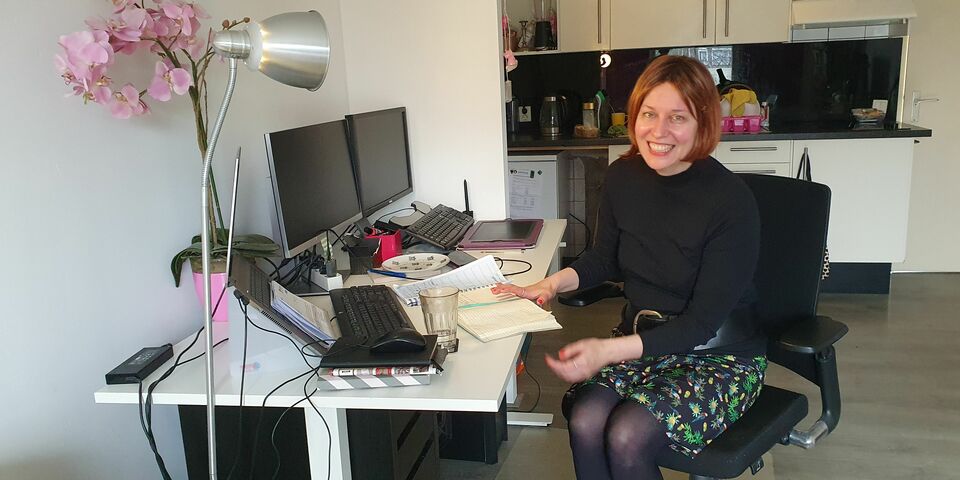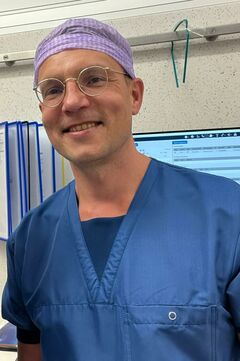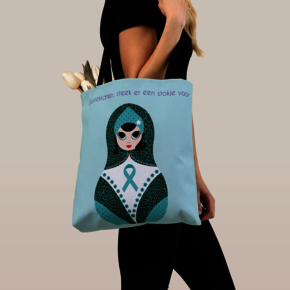Funding ovarian cancer research with matryoshkas
Energetic, creative and positive are words that characterize Mabel van Eck. When you see her bouncing around you don’t think of chemotherapy, ovarian cancer or merchandising. And yet, that is what we’re going to talk about, because the TU/e employee is on a mission: “We need more attention and research funding for ovarian cancer.”
Mabel van Eck (47) works at Industrial Design in student administration. In her free time, she likes to design beautiful things and exercises at the Student Sports Center. Last spring, she noticed that her lower abdomen was more swollen than usual. The general practitioner referred her and a cyst was discovered. It was supposed to be removed, after which Mabel would be able to go back to work and return to exercising. “But it turned out to be malignant and there were already metastases.”
Ovarian cancer is not very visible. It’s not on any of the signs in hospital aisles (“which do include cervical cancer and endometriosis") and the ovaries are hidden deep inside the body. The cancer initially causes few symptoms, but it metastasizes very easily. That is why it has the nickname “silent lady killer”. In Mabel’s case, too, the symptoms only manifested themselves when there were already metastases.
The disease – which has a five-year survival rate of 35 percent – is rare, with approximately 1,200 women diagnosed in the Netherlands each year. Her gynecologic oncologist Jurgen Piek of the Catharina Hospital sees an average of two new patients every week. “That's because all the patients with this disease in the Brabant region are referred to the Catharina Hospital, since we have an oncology center here,” says Piek.
Flushing the abdominal cavity
Mabel underwent chemotherapy three times to shrink the tumors and metastases. She then had surgery to remove the remaining tumor tissue and to apply HIPEC. Piek: “During HIPEC surgery, the abdominal cavity is flushed with heated chemo for an hour and a half to target any remaining cancer cells.” This intensive surgery was followed by another three rounds of chemotherapy. “I was told during the bad new conversation that all of this takes about 30 weeks,” says Van Eck. Now – almost eleven months later – she is making a plan in consultation with the occupational health doctor to return to her workplace on floor 3 of Atlas.
Nanomedicines
The tumor in her abdomen suppresses the immune system, and even “hijacks” certain immune cells, causing tumor cells to multiply and possibly affect other organs. The team of TU/e professor of Precision Medicine Willem Mulder is developing nanomedicines that reprogram the immune system so that immune cells resume their normal functions and attack and dispose of tumor cells in a highly targeted manner. For now, Mabel is taking medication that affects her entire body. “But I feel fine, I’m still positive and I’m pushing forward.”
One of her main goals is to raise awareness of ovarian cancer. “Pink Ribbon sells bras for breast cancer research, I want to sell underwear for ovarian cancer,” she says energetically. And she has already started with what is currently attainable; she has designed bags that are now for sale, with the proceeds going toward research.
Queen Máxima
She found the traditional matryoshka dolls a great symbol for merchandising. “I’m starting with bags, because those are very visible items. But I also dream of starting a jewelry line. And I’d like to find good ambassadors for that. Ideally, I would like for Queen Máxima to wear my earrings or scarves to raise the profile of ovarian cancer.”
She also designed the website Stopeierstokkanker.nl, with basic information on the disease. “Many people don’t know much about ovarian cancer; I didn’t know anything about it at first.” A clear message is displayed on some models of the bags: “Eierstokkanker: steek er een stokje voor” [Put a stop to ovarian cancer].
The next step is to find a company to produce the bags. Currently, they are printed on individual request through the company Zazzle. “It would be even better if I could get a line of products sold through Hema or Bijenkorf. If I could share my story in Linda magazine or get cosmetics company L’Oréal to back me, that would speed things up.” It’s all moving a bit too slowly for the impatient Mabel, but the first steps have been taken.
Research
When it comes to research, there haven’t been any real developments for about forty years. “There was a small breakthrough ten years ago with the aforementioned HIPEC, but other than that, there have been no notable innovations. The cancer keeps finding ways to escape the treatment. A key reason for this is that the cancer cells divide very rapidly, leading to many mutations in the DNA,” explains oncologist Piek.
Research at TU/e
Still, a lot of efforts are being made across many studies, according to Piek. At present, there is ongoing research at TU/e in several areas; the medications themselves, scans prior to surgery and drug delivery.
First of all, the medication development. Jurgen Piek and Willem Mulder met because the Catharina Hospital is setting up a study into the suppressed immune system in women with ovarian cancer in collaboration with the Mulder lab. In 2019, Mulder and colleagues from the Radboud University Nijmegen Medical Center founded a company focused on reprogramming the immune system for ovarian cancer. Independently, professor of Chemical Biology Luc Brunsveld’s group is developing anti-cancer molecules.
In terms of the efficiency of surgeries, there is also room for improvement. Piek is working with the Video Coding group in Electrical Engineering led by Peter de With and Fons van der Sommen to investigate whether it is possible to accurately predict – based on CT scan information from women with metastatic ovarian cancer – whether surgery is feasible and how invasive the procedure would be. It is not uncommon for the ovaries, uterus and all the cancerous tissue in the abdominal cavity to have to be removed.
Slow-release gel
And finally, drug delivery is being optimized. In December, the Dankers lab, led by Patricia Dankers, received nearly half a million euros from the Dutch Cancer Society (KWF) for research into peritoneal cancer, a disease that often develops due to metastases of ovarian tumors. The company UPyTher, a startup from the Dankers lab, is doing research on drug delivery in the abdominal cavity. They are developing a gel that functions as a depot, gradually releasing chemotherapy. This ensures that the tumors are exposed to the chemotherapy longer, making the treatment more effective. “The plan is to also start using this gel for women with ovarian cancer at the Catharina Hospital in the future,” says Piek.
That sounds like music to Mabel’s ears. “That slow-release gel would be a fantastic development. Because then the cancer could be treated in a targeted way. With chemo, that’s very difficult at the moment.” She emphasizes that if anyone from the TU/e community feels called to do something for ovarian cancer, they may contact her.






Discussion